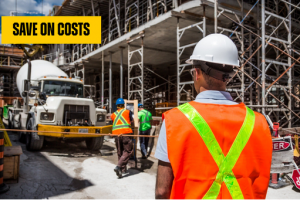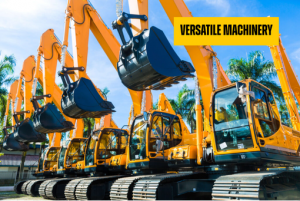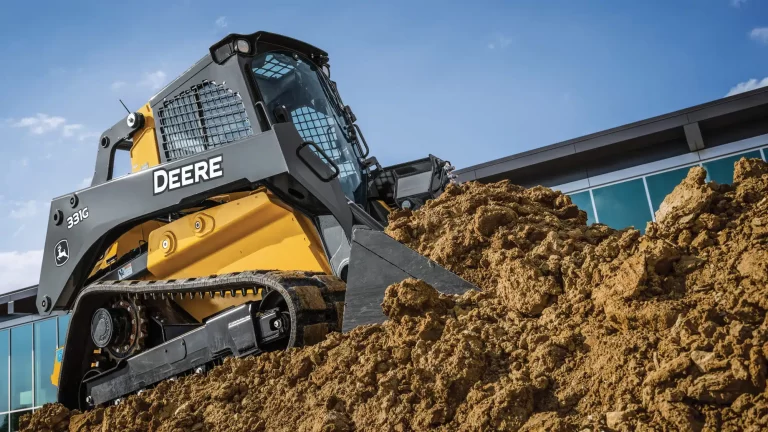Choosing to hire construction equipment isn’t just a convenient option; for many in the game, it’s a smart way to run a business. It’s all about keeping things flexible and your cash flow healthy, giving you access to the perfect machine for a specific job without the massive upfront cost and ongoing headaches of ownership.
Why Hiring Gear Beats Buying It
Let’s get straight to the point. For any bloke running a business, cash is king. Sinking tens, or even hundreds, of thousands of dollars into a piece of machinery that just sits in the yard between projects is a quick way to bleed your resources dry. Hiring equipment puts you back in the driver’s seat, letting you bring in top-tier gear exactly when you need it, for precisely as long as you need it.
Picture this: you’ve landed a big demolition job, and it needs a specialised rock crusher. It makes zero sense to buy one for a single project. Instead, you hire it, get the job done right, bill it to the project, and then send it back. Your money is free for the important stuff—wages, materials, and fueling your next job. The same thinking applies to smaller jobs, too. Maybe you need a mini skid steer for one landscaping gig or a tracked mini cement mixer for a tricky, tight-access pour. Hiring makes it easy.
The Hidden Costs of Ownership
The purchase price of a new machine is just the start. What many forget is the long list of ongoing expenses that chip away at your profits, year after year. These “hidden costs” are exactly why so many smart operators are now making the switch to hiring.
- Maintenance and Repairs: Every hour a machine is running, it’s one hour closer to its next service. When you hire, the rental company handles everything from routine oil changes to unexpected major repairs. That’s not your problem.
- Depreciation: Heavy machinery starts losing value the moment it leaves the dealer. It’s a silent killer on your balance sheet, wiping thousands off your company’s value each year.
- Storage and Security: You need a secure yard to keep your equipment safe, and that space costs money, whether it’s through rent or owning the property.
- Insurance and Registration: These are chunky annual bills that you completely sidestep when you hire.
A Growing Trend for Smart Contractors
This move towards hiring isn’t just a feeling; it’s a real trend reshaping the industry. The Australian construction equipment rental market was valued at around AUD 1.4 billion in 2024 and is forecast to hit AUD 1.54 billion by 2030. This boom is being driven by sharp businesses, especially small to medium-sized outfits, who get that dodging high upfront costs and maintenance risks is the key to staying profitable. If you’re interested, you can explore more data on the Australian equipment rental market and see the numbers for yourself.
The real advantage of hiring is being nimble. You can confidently bid on a wider variety of jobs because you’re not limited by the gear you own. Need a tamping rammer for a narrow trench today and a big plate compactor for a sub-base tomorrow? Hiring makes it happen without a second thought.
Choosing the Right Machine for the Job

Picking the wrong bit of kit is one of the fastest ways to burn through time and money on a project. Getting your construction equipment hire right from the start means matching the machine perfectly to what you’re actually doing on site. It’s all about practical thinking to avoid the headaches of underpowered or oversized gear.
The first step is a hard look at the task itself. Are you shifting bulk soil across a muddy, sloped block? In that case, a tracked site dumper is your best bet for stability and traction. A standard mini loader would likely just churn up the ground and get bogged. Thinking through these real-world scenarios before you ever pick up the phone is crucial.
Site Conditions and Access
Next, get real about your site’s limitations. How wide is the access gate? What’s the ground like – soft sand, hard clay, or finished paving you can’t afford to damage? These are the details that dictate your equipment choices. There’s no point hiring a wide machine if you can’t even get it down the side of the house.
For instance, if you’re backfilling a tight trench for plumbing, a narrow tamping rammer delivers that focused compaction power exactly where it’s needed. A bigger plate compactor might seem faster on paper, but it’s completely useless if it doesn’t fit in the trench. You can learn more about the specifics by checking out a pro’s guide to vibration plate compactors.
The Powerhouse Behind Your Tools: The Brüder Compressor
Beyond the primary machine, you need to think about what’s powering your tools. I’ve seen countless jobs grind to a halt because of a cheap, unreliable portable air compressor. This is exactly where hiring a quality unit like a Brüder screw compressor really pays for itself.
Brüder screw compressors are built differently. They’re engineered for continuous work, delivering a consistent, high volume of air all day long. This means your air-powered gear, like concrete cutters and jackhammers, runs at full strength without faltering.
This steady performance isn’t just about getting the job done faster; it’s about protecting your bottom line. Brüder units are built tough, which means far fewer breakdowns. That translates directly into massive savings on service costs and cuts out the expensive downtime that absolutely kills your profits. They’re the ideal power source for any serious construction equipment.
The Unsung Hero of a Productive Site
Not all hire gear is created equal, and this is especially true for the one machine powering your most critical tools: the portable air compressor. Opting for a cheap, unreliable unit is a guaranteed way to bring a productive site to a grinding halt. This is where making a smart choice in your construction equipment hire pays you back big time.
How To Handle The Hire Process
 Hiring equipment should be a straightforward part of the job, not a pain in the neck. When you know what to ask, what to inspect, and what to look for in the fine print, you can handle the process like a pro. It’s all about protecting your business and ensuring the transaction is smooth, so you can focus on the real work.
Hiring equipment should be a straightforward part of the job, not a pain in the neck. When you know what to ask, what to inspect, and what to look for in the fine print, you can handle the process like a pro. It’s all about protecting your business and ensuring the transaction is smooth, so you can focus on the real work.
There’s a good reason the construction equipment hire market in Australia is booming—it’s often the smartest way to get the job done. The market itself hit AUD 1.8 billion in 2024 and is tipped to grow to an estimated AUD 2.9 billion by 2033. This growth is fueled by contractors like us demanding easier access to machinery. You can read more about the Australian construction equipment rental market trends to see how the industry is evolving.
Before You Sign Anything
Before you even think about committing, you need absolute clarity on the total cost. A cheap daily rate can quickly spiral if it’s loaded with hidden fees you weren’t expecting.
Make a point of asking these key questions upfront:
- What are the transport costs? Get a firm quote for both delivery and pickup. Don’t leave it open-ended.
- What’s your fuel policy? Most companies operate on a “full-to-full” basis, but their refueling charges can be eye-wateringly expensive if you forget.
- What are the cleaning fees? A machine like a tracked mini cement mixer or a concrete cutter will need a thorough clean. Our guide to diesel pressure cleaners can help you find the right tool to avoid these extra charges.
- What does the insurance or damage waiver actually cover? Get specific. You need to understand exactly what you’re liable for if something goes wrong.
Getting these details in writing before you agree to the hire is the single best way to avoid a nasty surprise on the final invoice. It sets clear expectations for both you and the hire company.
When The Gear Arrives On Site
The moment the equipment lands on your site is your best chance to spot any pre-existing issues. Don’t just sign the delivery docket and wave the driver off. Take five minutes to do a thorough walk-around.
Here’s a practical inspection checklist to run through:
- Check the hour meter: Take a photo of the current hours. This is your undeniable proof against any disputes about overuse later on.
- Inspect for damage and leaks: Look for dents, cracks, and any oil or hydraulic fluid leaks. Pay close attention to the engine of a concrete cutter or the rams of a mini loader.
- Test key functions: For a tracked site dumper, check the condition of the tracks and make sure it tips smoothly. Fire up a tamping rammer to ensure it runs properly.
Document everything with your phone. A few photos can save you a thousand-dollar argument down the track. If you do spot a problem, report it to the hire company immediately—before you even start the machine. This simple step ensures you’re not held responsible for someone else’s neglect.
Using Hired Equipment on Your Site
Once that hired machine rolls onto your site, it’s on your watch. Getting the most out of it safely isn’t about ticking boxes; it’s about good habits and daily checks that keep the project moving and your team safe. These simple routines are your best defence against costly downtime and end-of-hire disputes.
A quick once-over each morning can stop a small niggle from turning into a major headache. Think about a tamping rammer – a ten-second oil check before the first start-up can be the difference between a productive day and a seized engine. Same goes for a concrete cutter; you wouldn’t dream of pulling that cord without first checking the blade is tight and free from fractures.
Safe Operation to Protect Your Crew and Budget
Every piece of machinery has its own feel, and getting to know its quirks is key to avoiding accidents. Operating safely is more than just reading the manual; it’s about developing a feel for how the machine responds on a busy, ever-changing worksite.
For instance, if you’re using a tracked mini cement mixer on a slope, you quickly learn to keep the heavy end of the load facing uphill to prevent it from tipping. With a mini skid steer, knowing how to connect and disconnect attachments without rushing is critical. A botched connection can easily blow a hydraulic hose, leaving you with a messy clean-up and a bill from the hire company.
Here’s the best advice I can give: if you or anyone on your crew feels unsure about a machine, stop. A quick phone call to the hire company for clarification costs nothing. It’s a thousand times better than explaining an accident or a busted piece of gear.
Your Construction Hire Questions Answered
To wrap things up, let’s tackle some of the most common questions we hear from construction pros about equipment hire. Getting clear answers to these upfront can save you a world of headaches down the line and help you make the right call for your next job.
Machinery hire is a huge part of the Australian construction scene. The industry has been growing steadily, hitting a market size of around AUD 4.0 billion between 2019 and 2024. While numbers can fluctuate, the trend is clear: hiring is a smart, standard strategy for contractors. You can read more about the construction machinery hire market size in Australia if you want to dig into the data.
What Happens If I Damage the Hired Equipment?
This is the big one. In nearly every hire agreement, you’re on the hook for any damage. Before you sign anything, carefully review the damage waiver or insurance options the hire company provides.
My best advice? Be diligent. Take detailed photos and even a quick video of the machine as soon as it’s delivered and again right before it’s picked up. This documentation is your best defence against any unfair claims and can be a lifesaver if a dispute arises.
Am I Responsible for Refueling the Machine?
Almost always, yes. The standard industry practice is a ‘full-to-full’ policy. The machine arrives with a full tank, and you’re expected to return it the same way.
Make sure you check the fine print in the agreement. If you forget to refuel it, the hire company will do it for you, but their refueling charges are almost guaranteed to be much higher than what you’d pay at the local servo.
How Long Is a Standard Hire Period?
Hire periods are designed to be flexible to suit your project’s needs. Common options include:
- Half-day (4 hours)
- Full-day (8 hours)
- Weekly
- Monthly rates
Generally, the longer you hire the gear for, the better the daily rate becomes. It pays to map out your project timeline accurately to lock in the most cost-effective construction equipment hire option.
Can I Get a Machine Delivered to My Site?
Absolutely. Any reputable hire company will offer delivery and pickup services, usually for an additional fee. This is pretty much essential for the big stuff like tracked dumpers or rock crushers that you can’t just throw on a ute.
The key here is to confirm all transport costs upfront. You don’t want any nasty surprises on the final invoice.
The smartest move is to choose quality from the start. A top-tier hire, like a Brüder screw compressor, prevents many common problems. Their high air output and ability to run without overheating means less stress on the machine and less chance of breakdown-related issues. Plus, their reliability significantly cuts down on potential service costs.
Hiring quality gear like a Brüder compressor isn’t just about avoiding damage; it’s about ensuring your tools—from concrete cutters to skid steer attachments—run at full power, maximising your productivity and keeping the job on track.
For equipment that delivers the performance and reliability your site demands, turn to Machtig Mobile Equipment. We supply premium European machinery, including the game-changing Brüder air compressors, designed for Australian conditions. Explore our range of powerful and efficient equipment today.





